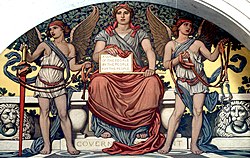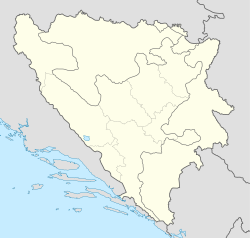초과적립금에 대한 마이너스 이자
Negative interest on excess reserves| 공공 재정 |
|---|
 |
초과적립금에 대한 부정적 이자는 시중은행들이 초과적립금을 중앙은행에 보유하는 데 비용이 많이 들어 민간에 더 쉽게 대출할 수 있도록 해 대출을 독려하기 위해 중앙은행이 적용하는 파격적인 통화정책의 수단이다.[1] 그러한 정책은 대개 매우 느린 경제 성장, 디플레이션, 그리고 디플레에 대한 대응이다.[2][3]
경기 침체기에는 중앙은행들이 성장 촉진을 위해 금리를 내리는 경우가 많다. 20세기 후반까지만 해도 은행들이 예치수수료를 내지 않고 현금을 보유하기 때문에 금리가 영하로 내려갈 수 없다고 생각했었다. 이것은 옳지 않은 것으로 밝혀졌다. 유럽과 일본의 중앙은행들은 금리가 마이너스가 될 수 있다는 것을 보여주었고, 몇몇 은행들은 처음에 금리를 0으로 낮춘 것과 같은 이유로, 즉 경기부양을 위해 그리고 물가상승률이 목표치에 미치지 못하는 곳에서 물가상승률을 올리기 위해 그들을 그러한 방향으로 밀어붙였다.[4] 마이너스 금리는 시중은행들이 대출을 할 수 있는 훨씬 더 많은 인센티브를 제공할 것이라는 생각이다. 만약 대안이 중앙은행에 돈을 보관하거나 많은 현금을 보유하는 데 부과된다면, 은행에 의한, 심지어 저금리 환경에서도 자금조달의 가치가 없는 잠재적 대출 프로젝트로 보일 수도 있는 것이 지금 매력적으로 보일 수도 있다.[5]
Examples
Europe
The European Central Bank and central banks of other European countries, such as Sweden, Switzerland, and Denmark, have paid negative interest on excess reserves—in effect taxing banks for exceeding their reserve requirements—as an expansionary monetary policy measure.[6][7][8][9][10]
Negative rates in Europe have been controversial. Ambrose Evans-Pritchard of the London Telegraph has described them as a "calamitous misadventure."[11] Economists for the European Central Bank argue that across the euro area, loans from banks to corporations have become less expensive since negative rates were adopted.[12]
Japan
In January 2016, the Bank of Japan followed European central banks and lowered its interest rates below zero, after several years of keeping them at the lower end of the positive range.[13] The existing balances will keep on yielding a rate of 0.1 percent; the reserves that banks are required to keep at the BOJ will have a rate of zero percent, and a rate of minus 0.1 percent will be applied to any other reserves.
United States
The staff of the U.S. Federal Reserve prepared a memo for the Federal Open Market Committee in August 2010 evaluating the possibility of lowering the interest rate that the Fed paid on bank reserves to zero or below.[14] The staff was lukewarm on the idea, and it was never adopted in the U.S. Former chairman of the Federal Reserve Ben Bernanke has argued that "negative rates appear to have both modest benefits and manageable costs" and "modestly negative" interest rates should be an option for the Fed to consider if it ever again confronts a very weak economy at a time when short-term interest rates already have been cut to zero.[15]
See also
- Constant purchasing power accounting
- Excess reserves
- Forward guidance
- IOER – interest on excess reserves
- Negative interest rate
- Quantitative tightening
- Zero interest rate policy (ZIRP)
참조
- ^ "Negative interest rates in Europe: A Glance at Their Causes and Implications". World Bank. worldbank.org. June 2015. Retrieved 5 February 2016.
- ^ Roubini, Nouriel (January 14, 2016). "Troubled Global Economy". Time Magazine. time.com. Retrieved 5 February 2016.
- ^ Dent Jr., Harry (February 5, 2016). "Negative Interest Rates Are the Next Stage in Global Stimulus". Economy & Markets. economyandmarkets.com. Retrieved 9 February 2016.
- ^ Linnemann Bech, Morten; Malkhozov, Aytek (March 6, 2016). "How have central banks implemented negative policy rates?". BIS Quarterly Review. Retrieved 27 January 2017.
- ^ Wessel, David; Olson, Peter (April 11, 2016). "The Hutchins Center Explains: Negative interest rates". Brookings Institution. Retrieved 27 January 2017.
- ^ Ward, Andrew; Oakley, David (27 August 2009). "Bankers watch as Sweden goes negative". Financial Times. London.
- ^ Goodhart, C.A.E. (January 2013). "The Potential Instruments of Monetary Policy" (PDF). Financial Markets Group Paper (Special Paper 219). London School of Economics. 9-10. ISSN 1359-9151. Retrieved 13 April 2013. Cite 저널은 필요로 한다.
journal=(도움말) - ^ Blinder, Alan S. (February 2012). "Revisiting Monetary Policy in a Low-Inflation and Low-Utilization Environment". Journal of Money, Credit and Banking. 44 (Supplement s1): 141–146. doi:10.1111/j.1538-4616.2011.00481.x.
- ^ Thoma, Mark (August 27, 2012). "Would Lowering the Interest Rate on Excess Reserves Stimulate the Economy?". Economist's View. Retrieved 13 April 2013.
- ^ Parameswaran, Ashwin. "On The Folly of Inflation Targeting In A World Of Interest Bearing Money". Macroeconomic Resilience. Retrieved 13 April 2013.
- ^ Evans-Pritchard, Ambrose. "Negative interest rates are a calamitous misadventure". The Telegraph. Retrieved 27 January 2017.
- ^ Wessel, David; Olson, Peter. "Are negative rates a "calamitous misadventure"? ECB economists say no". Brookings Institution. Retrieved 27 January 2017.
- ^ Mayger, James (January 29, 2016). "Bank of Japan's Negative Interest Rate Decision Explained". Bloomberg. bloomberg.com. Retrieved 5 February 2016.
- ^ "Options for Further Monetary Policy Stimulus" (PDF). Federal Reserve System. federalreserve.gov. August 5, 2010. Retrieved 27 January 2017.
- ^ Bernanke, Ben. "What tools does the Fed have left? Part 1: Negative interest rates". Brookings Institution. Retrieved 27 January 2017.
외부 링크
- ECB가 마이너스 금리를 도입한 이유는? (유럽중앙은행, 2014년 6월)
- "ECB의 마이너스 금리: 연방준비제도이사회(Fed May Be Forced To Follow This Lead)" (전 댈러스 연방준비제도이사회 회장 밥 맥티어, 포브스, 2014년 6월 5일)
- 유럽중앙은행(ECB)의 마이너스 금리가 경제 호재가 될 것인가(Simone Pathe, PBS Newshour, 2014년 6월 9일)
- "Japan adopts negative interest rates in surprise move". BBC. 29 January 2016. Retrieved 29 January 2016.
추가 읽기
- 키스터, 토드 (2011년 11월 16일) 금리 '제로 하한' 이유는? 뉴욕 연방준비은행. 리버티 스트리트 이코노믹스 블로그. 2020년 4월 2일 회수.
- Weisenthal, Joe (August 8, 2019). "The Non-Weirdness of Negative Interest Rates". Bloomberg Businessweek. Retrieved 8 August 2019.


